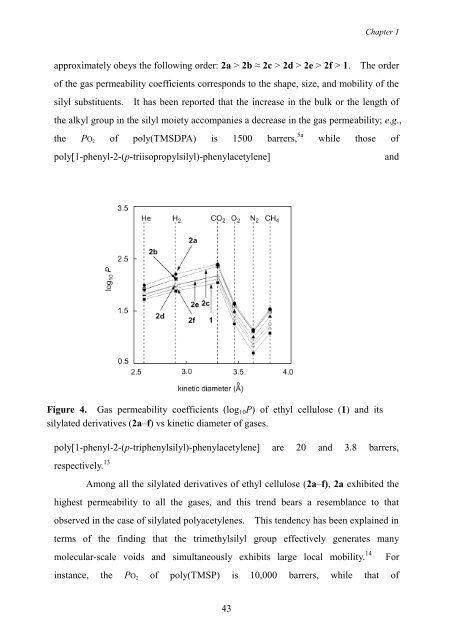Synthesis, Characterization, and Gas Permeation Properties
Synthesis, Characterization, and Gas Permeation Properties
Synthesis, Characterization, and Gas Permeation Properties
Create successful ePaper yourself
Turn your PDF publications into a flip-book with our unique Google optimized e-Paper software.
43<br />
Chapter 1<br />
approximately obeys the following order: 2a > 2b ≈ 2c > 2d > 2e > 2f > 1. The order<br />
of the gas permeability coefficients corresponds to the shape, size, <strong>and</strong> mobility of the<br />
silyl substituents. It has been reported that the increase in the bulk or the length of<br />
the alkyl group in the silyl moiety accompanies a decrease in the gas permeability; e.g.,<br />
the PO2 of poly(TMSDPA) is 1500 barrers, 5a while those of<br />
poly[1-phenyl-2-(p-triisopropylsilyl)-phenylacetylene] <strong>and</strong><br />
Figure 4. <strong>Gas</strong> permeability coefficients (log10P) of ethyl cellulose (1) <strong>and</strong> its<br />
silylated derivatives (2a–f) vs kinetic diameter of gases.<br />
poly[1-phenyl-2-(p-triphenylsilyl)-phenylacetylene] are 20 <strong>and</strong> 3.8 barrers,<br />
respectively. 13<br />
Among all the silylated derivatives of ethyl cellulose (2a–f), 2a exhibited the<br />
highest permeability to all the gases, <strong>and</strong> this trend bears a resemblance to that<br />
observed in the case of silylated polyacetylenes. This tendency has been explained in<br />
terms of the finding that the trimethylsilyl group effectively generates many<br />
molecular-scale voids <strong>and</strong> simultaneously exhibits large local mobility. 14 For<br />
instance, the PO2 of poly(TMSP) is 10,000 barrers, while that of

















